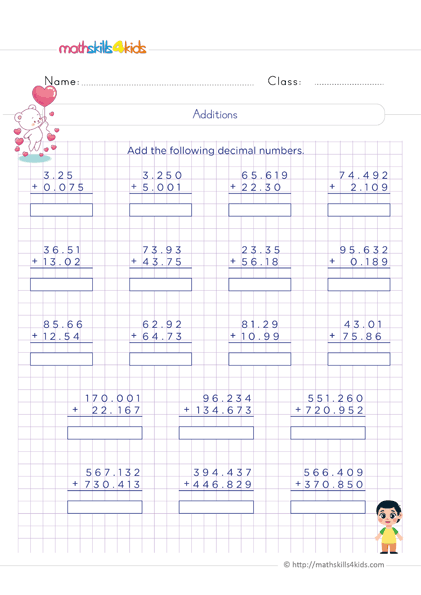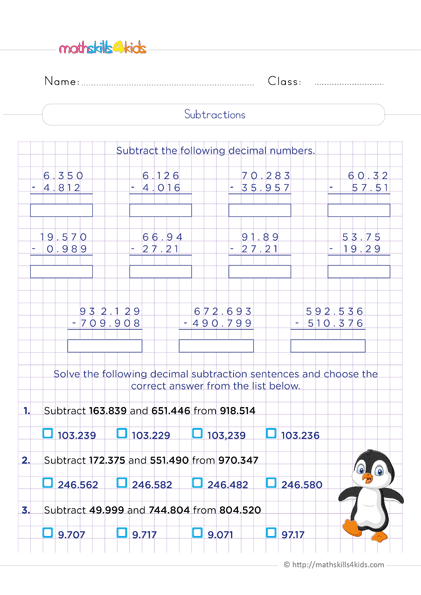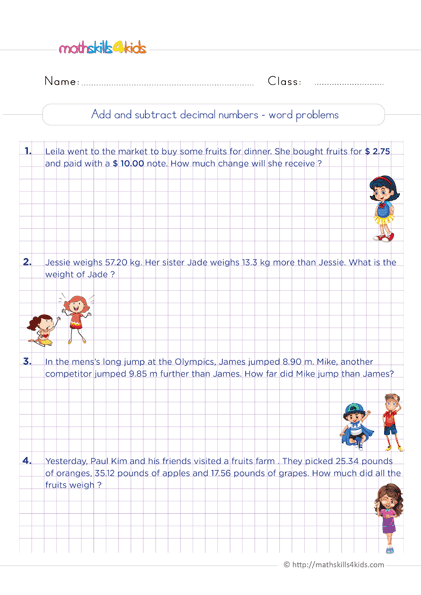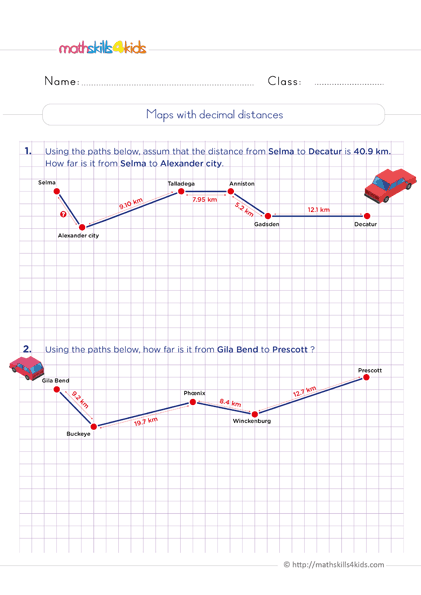6th Grade decimal addition and subtraction: Free printable worksheets
Welcome to our comprehensive collection of free printable worksheets for 6th-grade decimal addition and subtraction! This article has been designed to help students master the fundamentals of decimal operations by recommending a fun and interactive way to practice.
-
Learn adding and subtracting of decimals with fun and engaging worksheets PDF for 6th Graders
With many classroom and real-life decimal addition and subtraction problems, your 6th graders will understand why these essential math skills are important for practice in 6th Grade. In addition, this article will illustrate the benefits of using printable worksheets for decimal addition and subtraction.
Also, understanding the basics and a step-by-step guide to solving decimal addition is our objective in this article. By so doing, we’ll reveal the common mistakes to avoid in decimal addition and tips for improving decimal addition skills.
On the other hand, while exploring decimal subtraction, we will discover fun techniques for solving decimal subtraction problems, common challenges in decimal subtraction, and how to overcome them.
Nevertheless, we’ll introduce you to Mathskills4kids.com, an amazing website with tons of free printable worksheets for 6th Grade decimal addition and subtraction, such as:
- Adding decimals
- Subtracting decimals
- Adding and subtraction decimals word problems
- Estimating sums and differences of decimals
- Maps distances with decimals
Apart from Mathskills4kids, we’ll include additional resources for practicing decimal addition and subtraction.
-
BROWSE THE WEBSITE
-
DOWNLOAD FREE WORKSHEETS
-
-
GRADE 6 MATH TOPICS
- Whole numbers
- Multiplication
- Division
- Exponents and square roots
- Number theory
- Decimals
- Add & subtract decimals
- Multiply & divide decimals
- Fractions & mixed numbers
- Add & subtract fractions
- Multiply fractions
- Divide fractions
- Integers
- Operations with integers
- Mixed operations
- Rational numbers
- Problems solving
- Ratio & proportions
- Percentages
- Measuring units
- Money math
- Consumer math
- Telling time
- Coordinate graph
- Algebraic expressions
- One step equations
- Solve & graph inequalities
- Two-step equations
- 2D Geometry
- Symmetry & transformation
- 3D Shapes
- Geometry measurement
- Data and Graphs
- Statistics
- Probability
-
Buying is supporting us!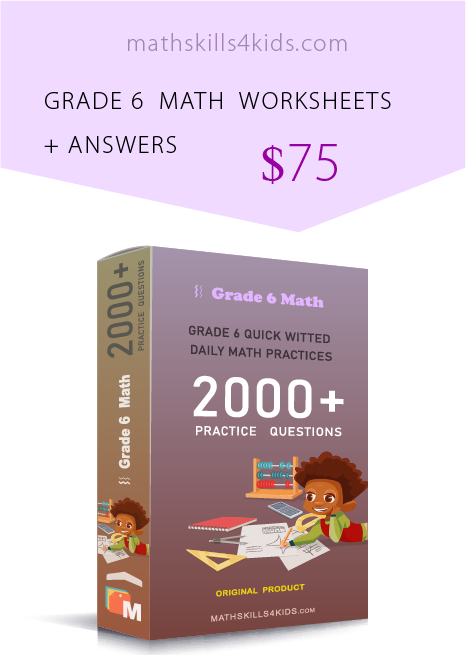
Buy Now...
-
-
Interest of 6th Grade Adding and subtracting decimals worksheets
Hello! Does your child know that decimals can also be added and subtracted as we do with whole numbers? However, the only difference is that decimal numbers are lined up according to the decimal point. To better understand this, visit Mathskills4kids.com and download the best adding and subtracting decimals worksheets PDF for 6th Graders’ classroom and home use.
Whether your child is just starting to learn about decimals or needs additional practice to reinforce their understanding, these carefully crafted worksheets are the perfect resource. From adding and subtracting decimals to solving word problems and working with decimal place values, each worksheet is thoughtfully created to cater to the specific needs of 6th-grade learners.
Also, with clear instructions and visually appealing layouts, our worksheets make learning decimal addition and subtraction a breeze. So, grab your pencils and prepare to sharpen those decimal skills with our free printable worksheets!
-
Why practice decimal addition and subtraction?
Decimal addition and subtraction are essential skills to practice in Grade 6 as they’re useful in many areas of advanced math, science, and everyday life. For example, decimal addition and subtraction are useful when we:
- Calculate money amounts, such as prices, discounts, taxes, tips, and change
- Measure lengths, weights, volumes, temperatures, and angles using the metric system
- Convert between different units of measurement, such as kilometers to meters, grams to kilograms, or liters to milliliters
- Compare and order decimals using place value and number lines
- Perform operations with fractions, percentages, ratios, and proportions
- Solve word problems involving decimals in various contexts
Decimal addition and subtraction are beneficial and versatile skills that will help 6th graders solve many problems. That's why your child needs to practice them regularly and master them before moving on to more advanced topics.
-
Benefits of using printable worksheets for 6th Grade decimal addition and subtraction
One of the best ways for 6th graders to practice decimal addition and subtraction is by using printable worksheets. These 6th Grade decimal addition and subtraction printable worksheets offer many benefits, such as:
- They provide a variety of problems with different levels of difficulty and formats, such as horizontal, vertical, column, grid, or word problems
- They allow students to practice at their pace and time, without the pressure of a timer or a teacher
- They give children immediate feedback on their answers so that they can check their work and correct mistakes
- They help you to track student’s progress and identify their strengths and weaknesses
- They make learning fun and engaging by using colorful graphics, themes, puzzles, games, and challenges
Using free printable worksheets for decimal addition and subtraction will help your 6th graders to reinforce their concepts, improve their accuracy and speed, boost their confidence, and prepare them for tests and quizzes.
-
Understanding the basics of decimal addition
Before we dive into the details of how to solve decimal addition problems, let's review some basics of decimal notation. A decimal is a number with a decimal point (.) separating the whole from the fractional part. For example:
3.14 = 3 + 0.14
The digits to the left of the decimal point are called the whole digits. They represent the ones, tens, hundreds, thousands, etc. The digits to the right of the decimal point are called the decimal digits. They represent the tenths, hundredths, thousandths, etc.
The place value of each digit in a decimal depends on its position relative to the decimal point. For example:
4.567 = 4 + 0.5 + 0.06 + 0.007
The place value of each digit in a decimal depends on its position relative to the decimal point. For example:
4.567 = 4 + 0.5 + 0.06 + 0.007
The place value of each digit is:
4: ones (1)
5: tenths (0.1)
6: hundredths (0.01)
7: thousandths (0.001)
To add decimals, we need to align the decimal points and add the corresponding digits in each place value column. For example:

We align the decimal points and add:
4 + 6 = 10 (write 0 in the ones column and carry 1 to the tens column)
1 + 5 + 1 = 7 (write 7 in the tenths column)
3 + 2 = 5 (write 5 in the whole column)
We write the decimal point in the same place as in the addends.
The final answer is 5.70.
-
A step-by-step guide to solving decimal addition problems
To solve decimal addition problems more efficiently and accurately, follow the step-by-step guide below:
- Write the addends one below the other in columns, aligning their decimal points.
- If one addend has more decimal digits than the other, add zeros to the right of the shorter addend until they have the same number of digits.
- Add each pair of digits in each column from right to left.
- If the sum of a pair of digits is greater than or equal to 10, write the ones digit in that column and carry the tens digit to the next column.
- Write the decimal point in the same place as in the addends.
- Write down the final answer.
For example:

Step 1: Write the addends one below the other in columns, aligning their decimal points.

Step 2: Add zeros to the right of the shorter addend until they have the same number of digits.

Step 3: Add each pair of digits in each column from right to left.

Step 4: If the sum of a pair of digits is greater than or equal to 10, write the ones digit in that column and carry the tens digit to the next column.

Step 5: Write the decimal point in the same place as in the addends.

Step 6: Write down the final answer.
The final answer is 18.018.
-
Common mistakes to avoid in decimal addition
One of the most common mistakes students make when adding decimals is forgetting to align the decimal points. This can lead to incorrect answers and confusion. To avoid this mistake, ensure the decimal points are lined up vertically before adding the digits in each column. We can also use zeros as placeholders to fill in any empty spaces.
Another common mistake is not writing the decimal point in the answer. Sometimes, students may add the digits correctly but forget to include the decimal point in the final answer. This can change the value of the answer significantly. To avoid this mistake, always write the decimal point in the answer before adding the digits. We can also use a pencil to mark where the decimal point should go before adding.
-
Tips for improving decimal addition skills
Practicing regularly is one of the best ways to improve decimal addition skills in 6th graders. You can use printable worksheets, online games, flashcards, or quizzes with your Grade 6 students to practice adding decimals with different numbers of digits and different places.
The more children practice, the more confident and accurate they will become.
Another way to improve decimal addition skills in 6th Grade students is to check their work. They can use a calculator, a friend, or a teacher to check their answers and see if they made any mistakes. They can also use different methods to check their work, such as estimating, rounding, or reversing the operation. Checking their work can help them catch and correct any errors and learn from their mistakes.
-
Exploring decimal subtraction
Decimal subtraction is similar to decimal addition but with one difference: the digits in each column are subtracted instead of adding them. Decimal subtraction is useful for finding the difference between two decimal numbers, such as prices, weights, lengths, or temperatures.
To subtract decimals, we need to follow these steps:
- Align the decimal points of the two numbers vertically.
- Add zeros as placeholders to make the numbers have the same number of digits.
- Subtract the digits in each column, starting from the rightmost column and moving left.
- Write the decimal point in the answer below the decimal points of the two numbers.
- Simplify the answer by removing any leading or trailing zeros.
For example, to subtract 3.25 from 7.8, we can do this:

-
Techniques for solving decimal subtraction problems
Using a number line is one technique that can help solve decimal subtraction problems. A number line is a horizontal line that shows numbers and their relative positions. We can use a number line to visualize how far apart two decimal numbers are and how much we will subtract to find their difference.
To use a number line to subtract decimals, follow these steps:
- Draw a number line and mark the two numbers that will be subtracted on it.
- Draw an arrow from the larger to the smaller number and label it with the difference.
- Count how many units or fractions of units are needed to move along the arrow to get from one number to another.
- Write the difference as a decimal number.
For example, to subtract 2.4 from 5.6 using a number line, we can do this:

Using compatible numbers is another technique that can help us solve decimal subtraction problems. Compatible numbers are easy to work with mentally, such as multiples of 10, 100, or 1000. We can use compatible numbers to estimate or round the numbers we want to subtract and adjust the answer accordingly.
To use compatible numbers to subtract decimals, we can follow these steps:
- Identify two compatible numbers close to the two numbers we’ll subtract.
- Subtract the compatible numbers mentally or using paper and pencil.
- Compare the compatible numbers with the original ones to see how much they differ.
- Adjust the answer by adding or subtracting the difference.
For example, to subtract 6.73 from 9.58 using compatible numbers, we can do this:
9.58 - 6.73 = ?
Compatible numbers: 10 - 7 = 3
Difference: (10 - 9.58) - (7 - 6.73) = 0.42 - 0.27 = 0.15
Adjustment: 3 - 0.15 = 2.85
Answer: 9.58 - 6.73 = 2.85
-
Common challenges in decimal subtraction and how to overcome them
One of the common challenges that students face when subtracting decimals is borrowing or regrouping. Borrowing or regrouping is when one unit is taken from a higher place value and added to a lower place value to make a larger number. We borrow or regroup when the digit in the subtrahend (the number being subtracted) is larger than the digit in the minuend (the number being subtracted from) in the same column.
To borrow or regroup when subtracting decimals, we need to follow these steps:
- Identify the column where we need to borrow or regroup.
- Go to the next column to the left and find a non-zero digit.
- Subtract one from that digit and add 10 to the digit in the column where we need to borrow or regroup.
- We’ll repeat steps 2 and 3 until we reach the column where we need to borrow or regroup.
- Subtract the digits in each column as usual.
For example, to subtract 4.67 from 8.2, we will do this:

Step 1: We need to borrow or regroup in the hundredths column because 7 is larger than 0.
Step 2: We’ll go to the next column to the left and find a non-zero digit. In this case, it is 2.
Step 3: Subtract one from 2 and add 0. It becomes 10.
Step 4: We’ll repeat steps 2 and 3 until we reach the hundredths column. However, we don't need to repeat in this case because we are already there.
Step 5: Subtract the digits in each column as usual.

Another common challenge students need help with when subtracting decimals is dealing with negative numbers. Negative numbers are less than zero and have a minus sign (-) in front of them. Negative numbers represent situations where something is taken away, lost, or below a certain level.
To subtract decimals with negative numbers, we need to follow these rules:
- If both numbers are positive, we subtract them normally and keep the sign positive.
- If both numbers are negative, we subtract them normally and keep the sign negative.
- If one number is positive and one is negative, we add their absolute values (the values without the signs) and use the sign of the number with the larger absolute value.
For example, to subtract -3.4 from -5.6, we will do this:
5.6 - (-3.4) = ?
Rule: If both numbers are negative, subtract them normally and keep the sign negative.
5.6 - (-3.4) = -5.6 + 3.4 = -2.2
Answer: -5.6 - (-3.4) = -2.2
-
Printable worksheets for decimal addition and subtraction
One of the best ways for 6th Grade students to practice and master decimal addition and subtraction is to use printable worksheets that provide different types of problems and challenges. Printable worksheets can help them review what they have learned, test their skills, and apply their knowledge to real-world situations.
Here are some examples of Mathskills4kids’ free printable worksheets for 6th Grade decimal addition and subtraction that you can use:
- Adding decimals: This worksheet provides problems requiring students to add two or more decimal numbers with different numbers of digits and places.
- Subtracting decimals: This worksheet provides problems requiring 6th graders to subtract two decimal numbers with different numbers of digits and places.
- Adding and subtraction decimals word problems: This worksheet provides word problems that require children to use decimal addition and subtraction to solve real-life situations involving money, measurements, or fractions.
- Estimating sums and differences of decimals: This worksheet provides problems that require learners to use compatible numbers or rounding to estimate the sums and differences of decimal numbers.
- Maps distances with decimals: This worksheet provides problems that require students to use decimal addition and subtraction to find the distances between different locations on a map.
Bonus: additional resources for practicing decimal addition and subtraction
To give your 6th graders more practice on decimal addition and subtraction problems, you can check out these online resources that offer interactive exercises, games, videos, and quizzes.
- Math Goodies: This website has a section on decimal addition and subtraction that covers the concepts, rules, examples, and practice problems. You can also encourage your learners to take a self-checking quiz to test their skills. https://www.mathgoodies.com/math-videos/add-subtract-decimals.
- Math Games: This website has a variety of fun and engaging games that let students practice decimal addition and subtraction in different contexts, such as shopping, racing, and solving puzzles. You can choose their grade level and difficulty level. https://www.mathgames.com/skill/6.40-add-and-subtract-decimal-up-to-100.
- Khan Academy: This website has a comprehensive collection of videos, articles, and exercises that teach them everything they need to know about decimal addition and subtraction. You can also track their progress and earn badges. https://www.khanacademy.org/math/arithmetic/arith-decimals.
- Math Playground: This website has a selection of games and activities that help 6th graders practice decimal addition and subtraction in a fun way. They can also watch videos that explain the concepts and strategies. https://www.mathplayground.com/index_fractions.html.
-
-
Thank you for sharing the links of MathSkills4Kids.com with your loved ones. Your choice is greatly appreciated.
Conclusion
Decimal addition and subtraction are essential skills that we use in many real-life situations, such as:
- Measuring lengths, weights, temperatures, and distances using decimals
- Calculating money amounts using decimals
- Comparing prices using decimals
- Estimating quantities using decimals
- Converting units using decimals
Practicing decimal addition and subtraction regularly will make 6th Grade students more confident and fluent in working with decimals. They will also develop number sense and problem-solving skills. Remember to use Mathskills4kids free printable worksheets and other resources this article proposes to reinforce your student’s learning. Before you know it, they’ll have fun with decimals!
